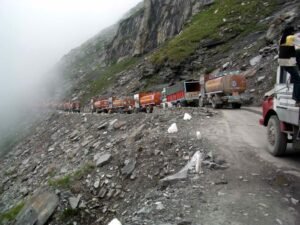Jammu and Kashmir Revives the Historic Darbar Move Tradition
|
General Studies Paper II: Federalism |
Why in News?
Jammu and Kashmir is set to revive the historic ‘Darbar Move’ tradition after 4 years of suspension, bringing back the seasonal shifting of offices between Srinagar and Jammu. It symbolises administrative unity and cultural connection.
What is the Historic ‘Darbar Move’ Tradition?
- About: The Darbar Move is a biannual administrative practice. Under this tradition, the government shifts offices between Srinagar and Jammu twice every year.
- Purpose: The tradition aims to ensure administrative access for both regions. The move promotes cultural and linguistic contact between Jammu and Kashmir. It also served as a political symbol of unity.
- Seasonal Schedule: Under this tradition, the secretariat works from Srinagar in summer months and Shifts to Jammu for the winter months. Typically the cycle ran from May to October in Srinagar and then operates from November to April in Jammu.
- Suspension: After a 2020 J&K High Court ruling observed that there was no “legal justification or Constitutional basis” for the Darbar Move. Soon, the administration halted the practice in 2021 to cut costs and to promote e-governance. Authorities ordered offices to function from both capitals without seasonal transfer.
Historical Background of the Darbar Move
- The Darbar Move began in 1872 under the rule of Maharaja Ranbir Singh, the Dogra ruler of Jammu and Kashmir. The Maharaja decided to shift his royal court and secretariat between Srinagar and Jammu with the changing seasons. The main reason behind this decision was the severe weather conditions of the region. It created a sense of connection between the two culturally distinct areas.
- During the early years of the tradition, the entire royal administration used to travel together. The royal convoy used the Jammu–Srinagar route, which was about 270 kilometres long. The shifting included hundreds of horses, bullock carts, and later, motor vehicles as transport technology improved.
- Even during the British colonial period, the Darbar Move continued without interruption. After the Treaty of Amritsar in 1846, the Dogra rulers gained control over Jammu and Kashmir as a princely state. By the late nineteenth century, the Darbar Move had become a deeply established practice of the Dogra administration.
- After India’s independence in 1947, the Government of Jammu and Kashmir continued the Darbar Move. Even after the Kashmir conflict began in the late 1940s, the Darbar Move continued regularly. It also became an important event in the annual calendar of the state.
- In the 21st century, many critics argued that modern technology and digital record systems had reduced the need for physical shifting of offices. In 2021, the administration suspended the practice to save nearly ₹200 crore and promote e-governance.
Reasons Behind the Revival in 2025
- Restoration of Cultural Heritage: The revival of the Darbar Move in 2025 is seen as an effort to preserve a 150-year-old cultural and administrative tradition. The government aims to reconnect with the legacy, reviving this practice as a symbolic gesture to honour the region’s rich historical identity and to restore a sense of continuity after its suspension in 2021.
- Strengths Regional Unity: The decision reflects the government’s intent to bridge the emotional and administrative gap between the Jammu region and the Kashmir Valley. The government believes that alternating the seat of governance helps ensure that both regions receive equal attention and development opportunities. The move is designed to promote social integration.
- Economic Revitalization: The suspension of the Darbar Move had affected local trade, transport, and hospitality sectors, especially in Jammu. The 2025 revival aims to boost seasonal economic activity linked with the biannual migration of government offices and employees. Hotels, transporters, and small businesses are expected to have renewed income opportunities.
- Political Significance: The government views the revival as a step toward re-establishing administrative balance. The return of the move shows a commitment to responsive governance and to the concerns of both regions. It also sent a message of political stability and inclusiveness after years of administrative restructuring following the 2019 reorganization of Jammu and Kashmir into a Union Territory.
- Public Sentimental Value: The revival in 2025 is strongly influenced by public sentiment and demands from local organizations and employees’ unions. Many citizens view the Darbar Move as their collective identity and seasonal rhythm of life. Responding to these emotional and cultural appeals, the government reinstates the practice to strengthen trust and connection with the people.
Challenges of the Darbar Move
- High Logistical and Financial Costs: The Darbar Move requires shifting thousands of government employees and large volumes of official records twice a year between Jammu and Srinagar. The process involves heavy transport, fuel, accommodation, and security arrangements. This creates a major financial burden on the government budget.
- Administrative Disruption: Each seasonal transfer leads to weeks of administrative slowdown. Offices remain partly non-functional during the shifting period, causing delays in public services and policy implementation. Citizens face difficulties in accessing government departments as files and staff are in transit.
- Environmental Impact: The large-scale movement of vehicles contributes to carbon emissions, fuel consumption, and road congestion. The convoy movement and packaging materials increase waste generation. The repeated shifting harms sustainability goals and adds unnecessary strain to the fragile Himalayan ecosystem.
- Security Challenges: The convoy carrying official records and personnel passes through mountainous terrain that often faces landslides, snow, and security risks. Ensuring the safe movement of sensitive documents and staff requires large-scale deployment of police and transport resources. These challenges increase vulnerability to accidents and disruptions during extreme weather conditions.
|
About Maharaja Ranbir Singh
|
|
Also Read: The Jammu and Kashmir Reorganisation Amendment Bill 2025 |










